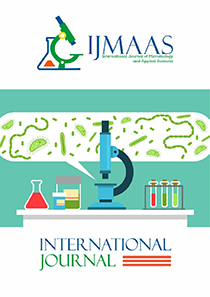Characterization and Molecular Identification of Some Microorganisms Isolated from Soil Exposed to Leachate from Septic Tanks
Vol 1, Issue 1, 2023
KEYWORDS
Septic tank leachate, soil, gene sequencing, pathogens, Bacillus, Myriodes, Aspergillus.
Abstract
This study was undertaken to access the microbiological quality of soil exposed to leachate from septic tanks in International Secondary School, Rivers State University, Port Harcourt, Nigeria. This was achieved by characterization and molecular identification of microorganisms in the soil samples. A total of 128 soil samples were aseptically collected from four sides of two septic tanks at vertical depths (0.0m, 0.5m, 1.0m and 1.5m) and at horizontal distances (0.5m, 1.0m, 1.5m and 2.0m) away from the septic tanks. Samples from same depth of each septic tank were bulked to form composite sample. Soil samples not exposed to septic tank leachate served as control. Collected samples were immediately taken to the laboratory for analysis using standard microbiological and molecular techniques. Results revealed mean counts of Total Heterotrophic Bacteria was 3.66 x 107 ± 2895cfu/g, Total Fungi 1.225 x 104 ± 0.83cfu/g, Total Vibrio 0.725 x104 ± 0.901cfu/g, Total Coliform 1.922 x104 ± 0.689cfu/g, Total Escherichia coli 2.05×104 ± 4.85cfu/g, and Anaerobic Plate Count 0.53 x 104 ± 0.968cfu/g. Mean counts of corresponding controls were lower. THB had the highest population which was above FAO/WHO maximum permissible limit. Results showed that highest population occurred at 0.0m depth (surface). Physiological characteristics of isolates showed presence of six bacterial genera; Bacillus, Pseudomonas, Micrococus, Kluyvera, Escherichia and Staphylococcus and eight fungal genera; Candida, Rhizopus, Penicillium, Mucor, Fusarium, Alternaria, Trichoderma and Aspergillus. Molecular sequencing identified Bacillus thuringiensis (strain Bi54 and strain HPPD), Bacillus firmus (strain T1), Bacillus megaterium (strain A20 and strain 3.5), Myriodes odoratimimus (strain F1), Bacillus altitudinis (NIOER258) and Bacillus cereus (CUMB CDB-09). This study detected microbes capable of causing diseases in soils exposed to septic tank leachate. Therefore, to protect human, animal and environmental health, implementation of modern sewage management system to avoid leaching of septic tank effluent should be vigorously pursued.
Current: Vol. 4, Issue 1, 2025

Call for papers
The International Journal of Microbiology and Applied Sciences warmly welcome your valuable articles for publication.
